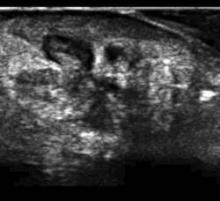PHOENIX — Methicillin-resistant Staphylococcus aureus abscesses, when compared by ultrasound with those caused by other pathogens, are smaller and more likely to lack a defined edge.
They are also more likely to have edema in surrounding tissue planes as well as pus divided into multiple pockets within the abscess, according to an abscess ultrasound study presented at the Society for Academic Emergency Medicine’s annual meeting.
The characteristics could make it more likely that an abscess is caused by methicillin-resistant Staphylococcus aureus (MRSA), helping guide antibiotic selection pending culture and sensitivity reports, said the study’s presenter, Dr. Dana Resop, an emergency department physician at the University of Massachusetts, Worcester.
The findings also indicate that additional factors—in addition to thick pus—make MRSA abscesses harder to drain than those caused by other pathogens, according to Dr. Romolo J. Gaspari, also an emergency department physician at the school.
The doctors and their colleagues assessed ultrasound images of 254 abscess, blinded to culture results until after the assessments were complete; 124 were MRSA positive.
They found MRSA abscesses are more than twice as likely as those caused by other pathogens to have no defined edge, to have edema in surrounding tissue planes, and have extensions to the skin surface.
They were also smaller and less likely to have ultrasound edge artifacts, thin black lines extending from the abscess edge away from the ultrasound probe.
Though odds ratios were not significant for shape, 26.7% of MRSA abscesses were lobated or ill defined, compared with 11.3% of non-MRSA abscesses.
The less well-organized nature of MRSA abscesses makes it harder to evacuate purulent matter and could contribute to the higher treatment failure rates found in a second study by the team, presented by Dr. Gaspari.
The second study compared incision and drainage (I&D) to ultrasound-guided, 18-gauge needle aspiration for draining abscesses.
The study included 101 abscesses, 54 treated by I&D, the rest by needle aspiration. All patients were treated with antibiotics. Failure was defined as the need for a second drainage.
The team found that 39% of MRSA abscess failed I&D, compared with 11% of non-MRSA abscesses; 92% of MRSA abscesses failed needle aspiration, compared with 55% of non-MRSA abscesses.
Overall, “aspiration’s just not as good as I&D,” Dr. Gaspari said.
When asked by an audience member if he thought the high MRSA failure rates in the second study were related to the physical characteristics of MRSA abscesses found in the first, Dr. Gaspari said, “I would say yes.”
Dr. Gaspari and Dr. Resop reported that they had no disclosures. The studies had no outside funding.


